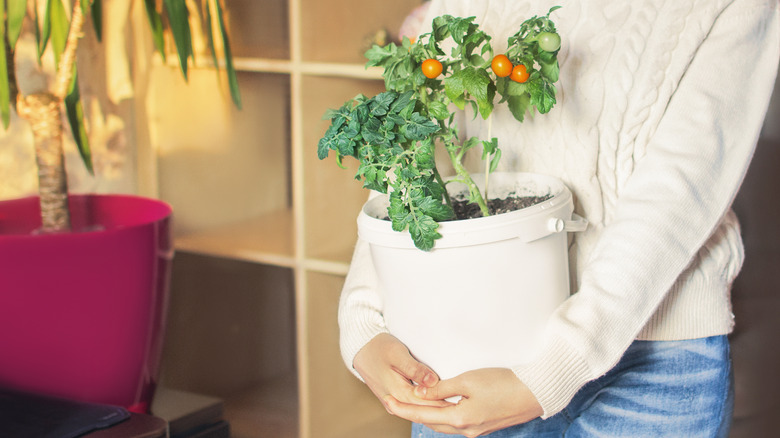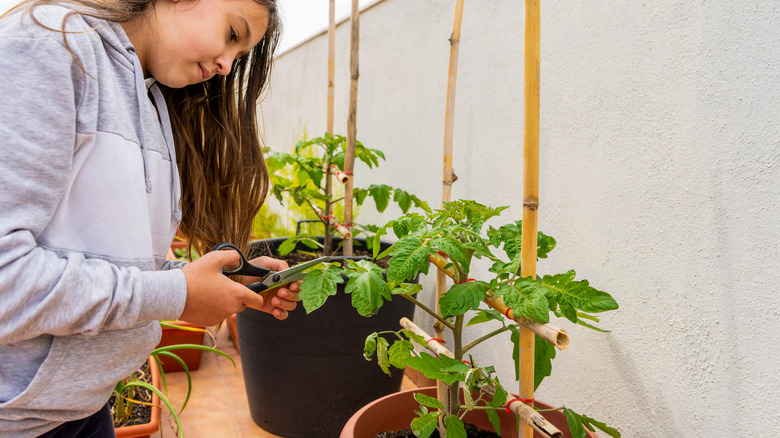10 Tips To Grow Tomatoes In Containers
Last year, we recommended 15 fastest-growing vegetables you'll absolutely love growing. But if you want the bragging rights of having a truly robust vegetable garden, a tomato section is indispensable. And here's why: Tomatoes have proven to be one of the most important vegetables you can have in your garden because of their multiple uses in salads, appetizers, and even tomato sauce.
However, tomatoes may prove to be one of the most difficult plants to grow as they're susceptible to infections. So, one gardening secret is to plant your tomatoes in containers to contain and narrow down all the possible things that could go wrong with starting a tomato garden, says Gardener's Oasis. Though not all tomato plants possess similarities in appearance, they do respond to similar tips for maintenance and growth methods.
With a prompt implementation of the right planting techniques, growing a tomato garden will be worth every bit of the effort. In that light, we have curated a list of 10 beloved, tested, and proven tips to grow tomatoes in containers just for you.
Choose large containers only
The first key to a flourishing container tomato garden is starting the process well. It is kind of like building a house from the ground up, as you need a solid foundation. What you want to do is ensure that you plant them in huge pots. Gardener Oasis recommends that the ideal pot for a tomato plant is an average size of 18 inches x 18 inches, and if you have a larger one, bigger is always better.
There are multiple benefits of using large pots for your tomato plant. According to research by The Spruce, using large containers ensures that you have enough space for deep planting your tomatoes and that the roots can stretch and become sturdier. The upside to this is that your tomatoes use less water and are much healthier. Also, as an extension, the greatest benefit of this is that your plant/garden is portable.
Clean up your containers
Tomatoes are rather prone to several diseases. However, if you would love to have strong healthy tomato plants, which of course you do, other than troubleshooting the issues as they arise, you need to grow your tomatoes in sterilized containers. Ideally, the best practice is to grow a new set of tomatoes in a new set of clean containers, writes Savvy Gardening.
However, if this is not feasible and you know that a plethora of tomato diseases get passed on from year to year in the containers and support, the next option would be the recommendation from Gardener's Oasis which says to wash them well. Now it's not enough to wash these containers with just soap and water. What you want to do is to take a mixture of 1/4 cup of chlorine bleach and combine this with a gallon of water. Once you have done this, make sure to empty the previous soil and clean the container thoroughly (emphasis on thoroughly, please). Note: It has to be chlorine bleach, otherwise the non-chlorine bleach is ineffective against bacteria.
Bury your tomato roots deep
Whether you are repotting your tomato plant or growing it right from the seed, the trick to getting long-lasting tomato plants is to give them a very solid foundation. What you want to do is to ensure that their roots are placed deep into the soil. According to The Spruce, while the majority of plant seeds should be placed at the same depth from the previous pot, tomato seeds should not.
Now, when planting a tomato seedling, first remove or pluck out a few of the leaves at the bottom for a start. That way, you have what we like to call an extended root. But not to worry, this will not affect your plant. The next step is to dig a hole in the container soil that is deep enough to accommodate almost the entire plant. The ideal root differs based on the size of the plant. Put the plant in the hole and cover it right up. A tomato plant will produce roots along the buried part of its stem, developing a strong root system and creating sturdier plants.
Tomatoes love moisture, but don't overdo it
Another gardening tip to getting the healthiest tomatoes and most bountiful harvest is to know just when, how, and where to water the plant. Now, according to Gardening Know How, you want to take things really slow and easy. You could employ a drip hose or a watering can to deliver water to your container tomato plant at the required speed. This would ensure that you do not flood the soil with water and wash away all the nutrients.
How often do you water your container tomato plants? While there is no hard and fast rule to this, the Tomato Bible states that your plants need about 1.5 inches of water per square foot. Also, Savvy Gardening writes that ideally, you should water your container plants every week. But in the heat of summer, you want to water your plants every two to three days. Your plant needs as much water as you do on those dreadfully hot days. Lastly, you want to water the tomato at the roots rather than from the top for best results.
Move your tomato plant in and out of the sun
Every green thumb knows that although plants require sunshine to grow, they do not want to be left out in the heat of the summer's scorching sun. Even you wouldn't. So, as suggested by the Los Angeles Times, best practices require that you try to take the heat off from 12 noon till 4 pm. This is rather easy to do because your tomatoes are planted in containers and thus are very mobile or portable.
While the above technique is essential for developing fruits, you could be much more creative with regular tomato plants, especially if you do not want to go through the trouble of moving the containers. Now you could get excellent companion plants that are large enough to provide shade like the Elephant Plant, says Garden Design. Another creative way to shield your plant from the sun is to mulch the soil and protect it from the hot breeze and direct sunlight. This can be done by covering the topmost layer of the soil with organic material, writes the USDA.
Be deliberate about the fertilizer
For bountiful harvests, even in containers, you need to be strategic and technical about the methods of fertilizing your plant. Ideally, we and Epic Gardening recommend that you should add a general fertilizer right when you plant, like on the spot. Then as the plants begin to adjust to their new homes, and they begin to bring forth fruit, you should fertilize again.
For the initial fertilization, you could either use organic fertilizer or chemical fertilizer, writes Gardening Know How. If you are working with organic fertilizer, you want to work it throughout the soil. However, if it is chemical fertilizer you will be working with, you want to ensure you do not burn the roots. To circumvent this problem, Epic Gardening recommends that you place a thin layer of normal soil in between the fertilizer and the little plant. Pro tip: Before you fertilize your plant, thoroughly water the plant to ensure that it has balanced nutrients.
Be meticulous about your tomato plant
We understand that the primary purpose of growing a tomato garden is for the sweet, fleshy, and juicy fruits — and then the bragging rights — but they work in tandem; it is either you get both or you get none at all. To ensure that your plant flourishes and successfully achieves its potential, the price to pay is not hell, but care and attention to detail when pruning. To that end, in between the crotch of two tomato branches, writes The Spruce, it is likely to develop independent suckers. However, these are wasteful as they will not bear fruit; they do nothing but suck energy, so your best bet is to cut them off.
However, you want to be strategic about pruning because, according to The Farmer's Daughter, fewer leaves, in turn, mean fewer sweet tomatoes. This is because it is the leaves that are photosynthesizing and creating the sugars that give flavor to your tomatoes. What you want to do is to cut out just the suckers and dry leaves — trust us, do not overdo it.
Prevention is always better than the cure
Tomatoes are prone to a bacterial infection known as pathogen bacterium Ralstonia solanacearum, which are most commonly found in moist and humid sand-heavy soils, says Plant Path. With this kind of infection and others, there is no exact practical cure, and so the best prevention method you can employ is to remove the diseased plants as soon as you notice them wilting. Thoroughly clean all tools used and then dispose of the diseased plants. (It is important to avoid using these plants as compost because it would only contaminate the soil further and cause for more infections, says Gardening Channel.)
As further preventative means, you can always employ one or more tricks, writes Gardening Channel. They include rotating the crops regularly, installing raised beds, spacing out the plants well for air circulation and ample growth, and finally, regulating the pH of the plant (6.2 at an average, and 6.5 at a maximum).
Ruffle the stems to make them stronger
Tomato plants, especially budding ones, are not exactly blessed with the strongest of stems. So, the onus is on you to make them stronger. According to The Spruce, tomato plants need to move and sway in the breeze to develop strong stems. If you are growing your tomatoes in the outdoors, the swaying is bound to happen rather naturally as the plant is exposed to all of the elements. However, since you are planting in containers and probably indoors, they recommend that you place a fan just by the containers to blow at the stalks and ensure that they develop stronger stems.
Where this is not possible, you could do it the old-fashioned way. Gently rough up your tomatoes by rubbing a hand inside at least twice a day. Be gentle or you will injure the plant. While this might take a little extra effort, it'll in turn reward you with a tropical tomato scent.
For the sturdiest tomato plants, re-pot twice
Whether you are growing your tomato from scratch or you are going to be purchasing seedlings, you should be prepared to re-pot your plants twice. According to Garden Betty, since tomatoes are one of the few plants that like to bury their stems in soil when growing them in contained spaces, you should attempt to recreate the same conditions as would be found in the expanse of nature. In turn, this brings about healthier and stronger plants with fewer needs for irrigation or fertilization because their extensive root system can reach deeper into the soil, pulling up moisture and nutrients.
To re-pot your tomato plant for the second time, Garden Betty recommends that you simply get a bigger container, clean it as we have discussed, and then loosen the root ball from the first home. Once you have done that, the next step would be to add fertilizer and the rest of the soil, then water your plant and wait for it to bring about the best of tomatoes that you have earnestly worked for.










